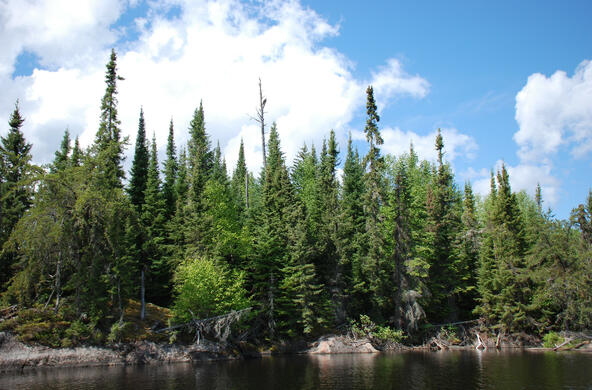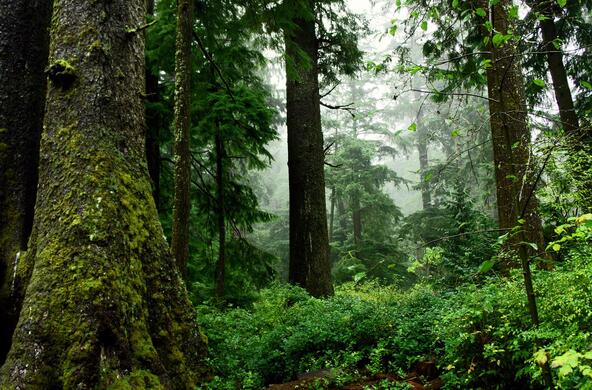On a cool day in late May, researcher Pamela Templer hikes through New Hampshire's White Mountains with ease, dodging an odd low-hanging branch as leaves and sticks crunch underfoot.
Although she's in the middle of a national forest, Templer's destination looks decidedly unnatural.
A cabin full of controllers and wiring sits plopped amid the trees. Newly erected power lines march up to the forest's edge. And a sign with a lightning-bolt graphic warning reads "Research Area: Do Not Walk Beyond This Sign."
This forest, Templer explains, is wired.
"Last summer, we buried almost 4 kilometers [2.5 miles] of heating cables in the ground," she said.
What Templer hopes to do with those cables, some shovels and a five-year experiment at the Hubbard Brook Experimental Forest is better understand the effect climate change might have on New England forests.
Simulating warming through 4-inch cables
While the effects of warming on forests have been studied before, Templer's experiment adds a unique and important twist.
Her warming cables, buried 4 inches deep, will simulate what will happen to the forests in summer as the climate warms. Those cables snake through four of Templer's six plots, which are about 40 by 46 feet in size, each with three red maples in their center.
The cables will heat the soil by 5 degrees Celsius during the growing season.
The maples, which are going to be measured for root growth and other factors, such as how well they take up nutrients from the soil, might actually like this warming, Templer explained. Other experiments that have warmed the soil have found that trees can grow faster and may be able to absorb more nutrients.
But those experiments fall short in their representation of the New England winter as the climate changes.
That's because they heat the ground year-round. In winter, at least for the next 100 to 200 years, New England soils will actually get colder as snowpack shrinks.
This is already happening. Records from Hubbard Brook, kept since the 1950s, have shown that snowpack in the forest has steadily decreased, and the snow that does fall stays on the ground for less time.
"It's somewhat counterintuitive, but snow actually acts like a blanket," Templer explained. "And so if you have a sufficient snowpack on the ground, all the organisms that live under that snowpack are snuggly warm. It's like being inside of an igloo."
That's why Templer's experiment adds a key element in the winter. When snow does fall, she is going to shovel it off two of the four plots that are getting added summer warming. The other two plots are a control.
"We are going to take away snow to induce soil freezing," she said.
Scientists probe warming and nitrogen link
Templer's prior research on how New England's forests respond to less winter snow has shown that without the protective snow blanket, soils freeze, causing damage to soil organisms and tree roots.
Scientists first noticed the damage frozen soils could cause to trees over two decades ago, when something strange happened at Hubbard Brook, which is continuously monitored because of its status as a research forest.
In the summer of 1990, scientists in the forest saw higher levels of nitrogen in the streams there, said Peter Groffman, an ecologist at the Cary Institute of Ecosystem Studies in New York, who has worked with Templer on experiments at the forest.
Other researchers in Northeastern forests noticed this happening, as well.
Normally, plant roots in the forest will soak up nitrogen as they come out of dormancy in spring and use it to grow. The scientists searched for a change that may have kept this from happening, so that more nitrogen flowed into the creeks.
They finally hypothesized that it had something to do with a very cold winter the year before, when there was a hard freeze before snow covered the ground. Groffman and Templer's experiments to date have borne this out.
Watching tree roots with a video camera
In various places in the forest, they trekked in during early winter and shoveled the first snow off some plots, so the soils there froze. Right next to those plots, they left the snow alone.
In the areas where they shoveled the snow and the soil froze, "nutrients came pouring out of the soil the following summer," Groffman said.
The freezing soil, it turns out, kills a lot of tree roots. One researcher, Geraldine Tierney, was able to see this by inserting a video camera into clear plastic tubes in the ground so she could watch what happened to the roots over the winter.
When soil freezes, said Groffman, the water in it turns into big balls of ice. The dynamic is similar to how a crack in the pavement, filled with water, gets ripped up in the winter when it freezes.
This happens with roots, too. The ice that forms in the frozen soil cuts the roots, damaging them so they can't take up nutrients like nitrogen, phosphorus and calcium.
"We've shown that early in the growing season, when the trees would normally be waking up and taking up water, or taking up nitrogen, they are doing much less of that. And we believe it is from damage caused by freezing in the previous winter," Templer said.
'Really pushing the frontiers'
The freezing can hurt animals that live in the soil, too. Templer found that the diversity and numbers of arthropods -- things like beetles and spiders -- were also reduced in areas where the soil froze because of lack of snow cover.
With her new experiment, Templer is finally able to put two parts of climate change -- warming summer soils and frozen winter ones -- together for the next five years. What she finds will perhaps paint one of the most reliable portraits to date of how climate change will affect the forests of New England.
Lindsey Rustad, a U.S. Forest Service forest ecologist who tracks more than 200 warming experiments worldwide, said Templer's experiment "is really pushing the frontiers."
"As far as I know, there is no other combination of warming and frost, so it is a very unique experiment," said Rustad.
Because of climate change, the forest is likely to see more extremes, like very hot summers and winters with a lot less snow.
"She is setting up a system that will allow her research group to look at extreme events, whether it is frost cycles or extreme temperature treatments," Rustad said.
Finding a solution for an 'iconic' species
Templer had to create her forest plots with red maples, rather than sugar maples, because she couldn't get electricity high enough into the forest to make warming plots that included sugar maples.
That is why 70 newly planted sugar maple and 70 red maple saplings sit just a short walk down the road from the wired cabin and forest plots, off to the side in a freshly dug patch of light-brown dirt.
Each of the saplings is buried in a pot in the ground, a self-contained unit. Templer plans to warm the soil around these, as well, and is also adding another variable to this set of experimental trees.
Researchers have predicted that sugar maples may move north as the climate warms. Yet another of the unknowns about how climate change will affect these trees is how changes to the freeze-thaw cycles in winter, with more periods of alternating warm and cold spells, could affect the roots, she said.
"If you think about the middle of winter, when we have these little hot spells, do the roots get damaged right away when they freeze, or is there some sort of threshold?" she said.
To test this, Templer will turn the warming cables on and off in some of the saplings, mimicking those freezes and thaws. She wants to see how if the trees respond differently if there are multiple freeze-thaw cycles or if it just takes one or two to affect them.
Sugar maples have long been symbols of the New England forest, and what happens to them is important not only to forest ecology, but to the region's economy and identity.
"It's such an iconic tree species for the Northeast," she said.






